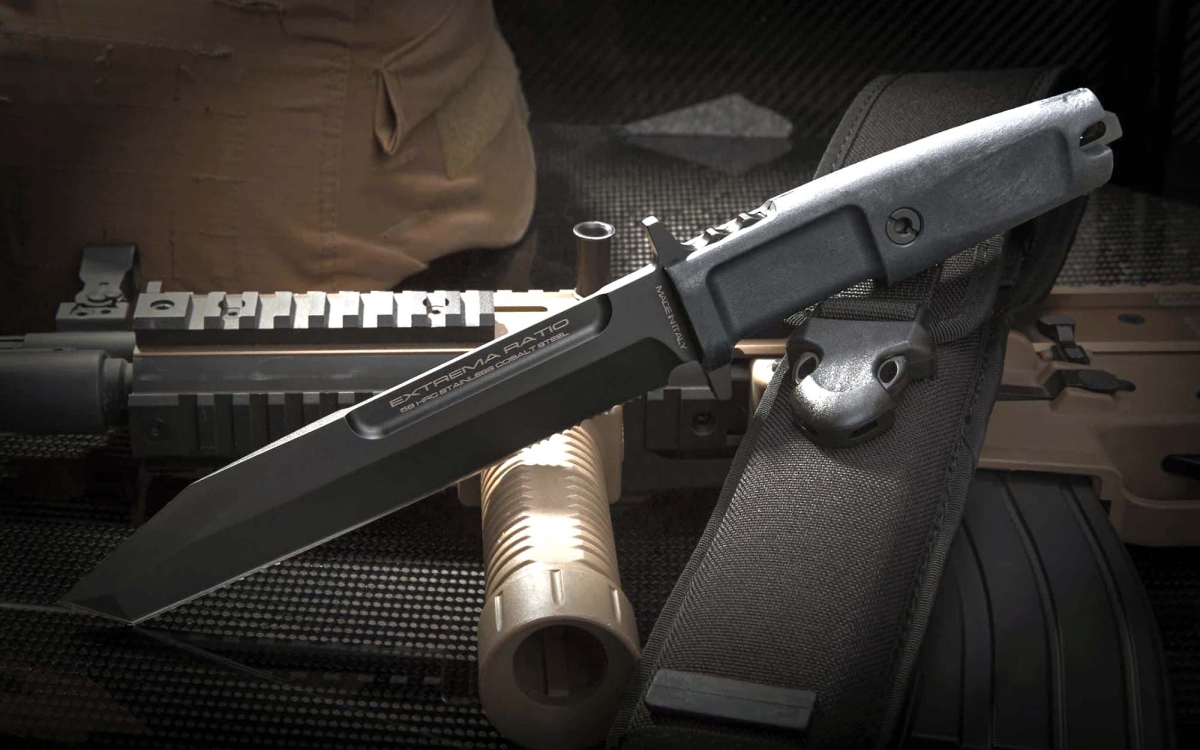Extrema Ratio Fulcrum knife torture use
Torture test: how about over ten years of heavy, careless, brutal, mercyless use of one of the most popular knives “Made in Italy”? The Extrema Ratio Fulcrum
The knife has been used as a heavy tool for over 10 years. The scabbard and harness are scuffed and dusty, but functionally perfect.
I’ve never been partial to so called “torture tests” where knives were put to such usage as cutting heavy gauge nails: in the best case scenario, the knife cuts the nail and we learn that hardened steel can cut through soft iron (what a breakthrough), in the worst one the knife breaks and we learn that knives are not meant to cut nails (surprise surprise…)
When we evaluate a knife’s durability and toughness based on daily use, we knife enthusiasts usually have a problem: we pamper our knives.
We clean every trace of dirt, we polish blade and grip, we oil every inch of carbon steel, we keep a flawless shaving-grade edge, we shed tears for every scratch on the blade finish. In a word: we suck.
So, I thought of something different, more realistic and meaningful to the final user.

An Extrema Ratio "NEW" Fulcrum knife: not mine, but that's how it looks just ut of the box
After years of heavy use and exposure to the elements, some minor discoloration under the grip is all there is to see.
Something closer to how a knife is used on the field as a daily tool by people who don’t give a rodent’s backside about finish and technical details and are only focused on getting the job done, people that find tool maintenance boring and weighing on already tight schedule, so they’ll perform just what they are forced to perform or what will keep the tool in reasonable working condition.
People who have a far broader concept of what a knife is supposed to be used for than your usual knife nut.
So, I got the knife: an Extrema Ratio Fulcrum S, which i choose as it had been adopted by the Italian Army in a role of multipurpose “tactical” knife meant to be used for all kinds of field tasks, and decided to use it as an average person would do in a difficult environment where the knife often is the only tool at hand.
The Fulcrum has been used to break coal for the forge, open cans and many other dirty, heavy tasks.
The knife underwent months of ruthless work:
- I used it to cut all kinds of materials, to pry open paint cans, to pierce oil cans to get the last dregs of oil out, to cut shrubs and branches, without bothering to wipe it clean after the job was done.
- I put it in salt water, wetted it, rubbed it with salt and put it in its sheath to see how well it fared against rust.
- I cleaned the spots of rust rubbing it with sand, I washed it summarily and used it to cut meat and vegetables, I used it to break coal for my forge and kept it on a bench in an open shed where it was exposed to the elements for years.
- I played with it throwing it at logs or into the ground, wiping it somewhat before re-sheathing.
- I resharpened it with a coarse scythe stone, with river stones, a couple of times with a 400-grit belt sander.
- I “polished” it with the slurry from the whetstone when it was too dirty and a lot more that right now, I can’t even remember because, you see, this was over ten years ago.
After over a decade of use, often exposed to gritty, abrasive materials, dirt and dust, the laser etchings are barely visible.
Over a decade of resharpening with improvised tools, the serrations are badly worn, but the blade works flawlessly all the same.
Worn, dirty, with a lotof scratches and discolorations, but perfectly serviceable.
After I wrote the review of the first, brutal test, I got to keep the knife (not surprisingly, as it was quite beaten up), and I continued to use it exactly the same way. It became my “tool shed knife” and the go to knife for any dirty, gritty, nasty job where I didn’t want to mess up the finish or edge of any other “fancy” knife, and it has been ever since.
Recently I’ve seen some call Bohler N6890 a “mediocre” steel comparing it to some other “wonder steels”, which is nonsense considering that plain carbon steel is still one of the best alloys to make knives, and heat treatment makes 90% of the blade, the other 90% being practical design (no, it’s not a mistake: after over 30 years of using knives I believe heat treatment and practical design both together contribute to 90% of a knife effectiveness).
So, I took my Fulcrum S and decided to take some pictures of it. What you see is how it looks after over ten years of heavy use and little to no maintenance.
The sheath is in pretty good conditions as it was only used as housing for the knife and kept on the bench, or on a peg on the wall, or hanging from a post vise in the open. Somewhat scuffed, but both scabbard and harness work flawlessly.
The laser etched markings are barely visible, the serrations in the blade worn by countless “field” sharpening (the blade never touched by specialty tools for serrated blades), which also messed up the milled “yokote” which, honestly, I don’t give a damn about.
The knife works well today as it did then, and I plan to get decades of use from it. Hell, I believe it’ll still work just fine when I’ll be long gone.
As I'm writing, it's hanging from an old post vise in my garden, exposed to all kind of weather, at hand for any kind of dirty work, from gardening and trimming bushes, to cutting bags of dirt or wood for starting the forge.
It's one of the best knives I've ever owned.



